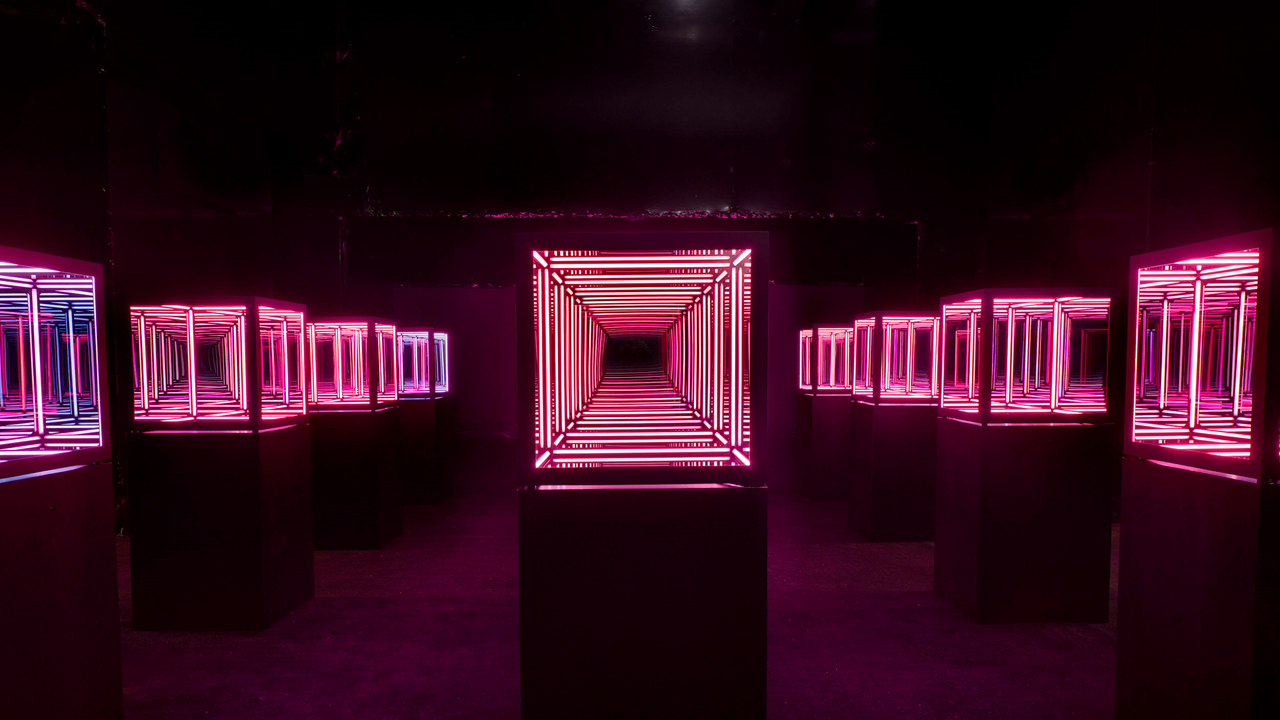ANTHONY JAMES
LIGHTFIELD
The Marble Arch Mound7 Septembre 2021 - 9 January 2022
The current exhibition, “Lightfield”, by the British-American artist Anthony James, can certainly be considered in such a context. Held inside London’s newest visitor attraction, Marble Arch Mound (which opened on the north-east corner of Hyde Park in July 2021), it consists of five stunning light pieces in a large dark space.

Anthony James
90" TriacontahedronSpecialized glass, LED, steel
228.6 x 228.6 x 228.6 cm I 90 x 90 x 90 in

Anthony James
Crystal 0012020
Stainless Steel, specialized glass, LED lighting, solar black
245.1 x 116.8 x 120.7 cm I 96.5 x 46 x 47.5 in
James himself sees the show holistically — as a kind of gesamtkunstwerk, where the overall experience of the works matters more than how we react to each one individually. He describes the exhibition as “fully immersive” and part of
an attempt to “transport visitors into another world to create a meditative and limitless narrative”.
On entering the space, one swiftly — and — completely forgets that Oxford Street is just a stone’s throw away.

When Donald Judd and his fellow Minimalists came along, in the 1960s, their sculpture had a different mode of addressing viewers than sculpture had previously had. Broadly speaking, these objects were abstract, large-scale and repetitive — and
confronted the viewer with their materiality, in some cases quite aggressively.
They also took geometric forms, with Judd in particular loving a cube. One can spot his influence on the principal work at Marble Arch Mound, Lightfield (after which the whole exhibition is named). It comprises 12 identical
cubes formed from stainless steel, glass and LED lights — and arranged in a grid of four by three.


Anthony James
Lightfield (12x 24" Transmorphic Cubes)2021
Stainless Steel, Glass, LED Lights
each cube: 61 x 61 x 61 cm I 24 x 24 x 24 in

Anthony James
24" Transmorphic Color Cube (Solar Black)
2021
Steel, LED lights, double sided glass
61 x 61 x 61 cm – 24 x 24 x 24 in
Enquire
Where James has divorced himself drastically from Judd, however, is in the piece’s theatricality. There’s nothing Minimalist about the way in which light of constantly varying colours and strengths shines within each cube, at the command
of a computer programme.
The cubes’ edges are made of the steel; their faces made of the glass; and the LED fixtures have been fitted internally on each edge. This results in a play of light for all of us to see. One
second, we’re confronted by deep blue with a hint of pink, the next a rich red with a touch of yellow. Words can in no way do justice, though, to the sheer array of illumination.
No matter how long a viewer stands before Lightfield,
he or she — reminiscent of Heraclitus in his Presocratic river — will never see the same configuration of lights twice. The illumination is carefully synchronised across the 12 cubes, such that what we end up with is a kind of
beautifully choreographed, incessant dance.

Anthony James
34" New Wall Portal (Solar Black)
2021
Steel, LED lights, double sided glass
86,4 x 86,4 x 86,4 cm - 34 x 34 x 34 in
Enquire


Anthony James
40’’ Bullet Painting
2019
Polished stainless steel
40 x 40 cm – 101.6 x 101.6 in


Anthony James
60" Great Stellated Dodecahedron (Solar Black)
2021
Steel, LED lights, double sided glass
152,4 x 152,4 x 152,4 cm I 60 x 60 x 60 in


Born in the small town of Rochford in Essex in 1974, James moved to London in the mid-1990s to study at Central Saint Martins College of Art and Design. Shortly after graduating, he relocated to New York City, and it was there that — in
his own words — he “began an infatuation” with the work of Donald Judd, the recently deceased American artist.
His first monograph, ‘Morphic fields’, was published by Hatje Cantz in 2014. His work has recently been exhibited
at Crystal Bridges Museum of American Art and is part of the Palm Springs Art Museum collection, USA. In 2020, he was selected to be part of the Mayfair Sculpture Trail, with his 97 inches high Crystal piece displayed in Old Bond
Street.

